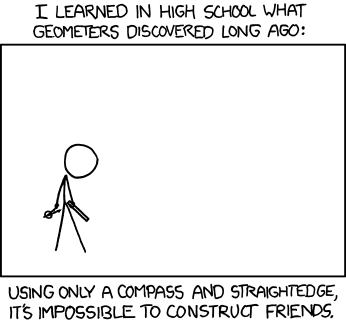866: Compass and Straightedge
| Compass and Straightedge |
 Title text: The Greeks long suspected this, but it wasn't until April 12th of 1882 that Ferdinand von Lindemann conclusively proved it when he constructed himself the most awesome birthday party possible and nobody showed up. |
Explanation[edit]
Compass and straightedge constructions are a class of problems in classical geometry. They take the form "Using only a compass and a straightedge, construct X", where X is a geometric figure such as a regular pentagon. The subject is typically covered in high school mathematics. Three such constructions (squaring the circle, trisecting the angle and doubling the cube) remained unsolved for thousands of years before being shown impossible with the use of modern algebraic techniques.
The comic begins as if it were stating a problem in classical geometry but veers into an observation that no amount of technical knowledge can substitute for human companionship. An additional layer of humor is that Cueball is a stick figure so technically it is possible to create friends with a straightedge and a compass, a figure constructed like Cueball is. Yet two other layers are the reference to the "straight edge" subculture that believes that one can find fun, friends and partners without alcohol and drugs and the fact that it claims one can construct a awesome birthday party using only two means that together often fail to construct even simple geometrical objects.
Ferdinand von Lindemann was a German mathematician who showed in 1882 that pi is not a zero of any polynomial with rational coefficients, i.e. it is a transcendental number. Transcendental numbers cannot be constructed with straightedge and compass. This proves that squaring the circle (a problem where it is required to construct a square with the same area as a given circle) is impossible, being as the sides of the square would need to be √π times the radius of the circle, and pi is not constructible.
Transcript[edit]
- I learned in high school what geometers discovered long ago:
- [Cueball, holding a compass and straightedge, looks sad.]
- Using only a compass and straightedge, it's impossible to construct friends.
Discussion
No, the comic is funny because many geometrical theorems prove something along the lines of "With a compass and straightedge you cannot construct..." (e.g. a square and a circle with the same area) If you have knowledge of this type of proof, the humor is that you think he's about to talk about something that is impossible in geometry, but really he's talking about the inapplicability of geometry to real life. This is often a difficulty with nerds and brainy people, they try to apply their theoretical knowledge to human relationships and fail. 75.103.23.206 19:53, 13 December 2012 (UTC)
- And then there's the converse: people who are able to apply theoretical knowledge and succeed. 76.106.251.87 04:33, 5 June 2013 (UTC)
At least in germany there is a "Straight Edge" movement of people that don't drink alcohol, tell they can have fun without sex before marriage, that if they show interest in a relationship they really mean it and paint an "X" on their Hands in order to warn everybody about this. "Straight edge" and "X" might possibly be a reference to that...--Gunterkoenigsmann (talk) 15:46, 4 March 2022 (UTC)
The explanation mentions that there are "three such constructions", but doesn't go any further. What they are should at least be addressed (or linked to), even if we're not going to elaborate on the "why" of their impossibility. For the uninitiated, they are squaring the circle, trisecting any angle, and doubling the cube. 76.106.251.87 04:33, 5 June 2013 (UTC)
If such constructions are "impossible with the use of modern algebraic techniques," then why don't we just use older algebraic techniques? ;) 213.203.138.251 (talk) (please sign your comments with ~~~~)
- Those "modern algebraic techniques" just did prove that you can't solve this constructions by using only "classical geometry".--Dgbrt (talk) 18:14, 29 June 2013 (UTC)
I tried forming a club for compasses and straight edges but no one signed up :( ~JFreund
Could the “most awsome birthday party“ bear another deeper meaning, for example be analogue to the rational polynom with rational coefficients? 162.158.202.100 04:30, 9 April 2017 (UTC)
Could this "most awesome birthday party" be a reference to Stephen Hawking's party for time travelers? Spagovir (talk) 18:33, 10 August 2017 (UTC)
- I'm pretty sure you're right, it sounds like a Hawking party reference to me too. - CRGreathouse (talk) 06:17, 8 August 2018 (UTC)
Anyone think of adding a reference to 710 Collatz Conjecture? Where in a similar vein, he begins by explaining the steps for applying the conjecture, then finishes up by losing all his friends. 108.162.246.17 16:26, 8 August 2018 (UTC)
There's some irony in the fact that Randall *could* give Cueball friends using only a compass and a straight edge, since Cueball himself can be drawn using only a compass (for the round head) and straight edge (stick figure).